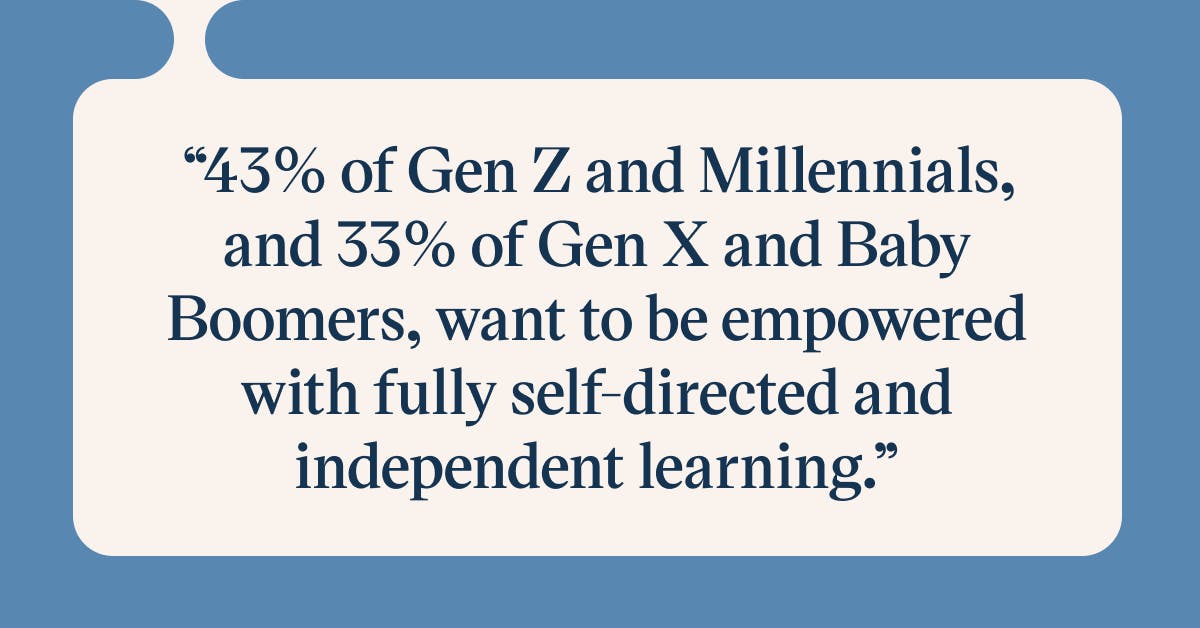
Top L&D trends for 2022

Now that 2022 has well and truly begun, it is the perfect time to reflect on some of the biggest L&D trends of the year so far, and look ahead to what the rest of the year may have in store.
While the year races by and clashing priorities pull you in different directions, it’s easy to lose track of the latest industry developments. What has been trending? How has it affected the L&D industry? What exciting developments can we have to look forward to for the rest of 2022? And, most importantly, how can your L&D team capitalise on these ongoing trends?
At Go1, we like to think we’re on top of the latest and greatest L&D trends, so, with all these questions swirling around, we decided to look at a few of the top L&D trends for 2022. We’ll examine the trends of empowering learners, soft skills, content aggregation, and improving D&I, analysing everything you need to know to stay up to date and informed on L&D trends.
Content aggregation
Content aggregation has emerged as one of the biggest L&D trends of 2022. As we touched on in our article on how learning content aggregation can benefit your L&D team, aggregators have become popular in many facets of everyday life, and L&D has not been exempt.
Content aggregation refers to the process of collecting a variety of different digital learning providers and making them available in one convenient, centralised location. For many L&D teams, this model can save the common pain point of trying to deliver suitable content to different teams and learning styles, all on tight time constraints and an even tighter budget. Usually, something has to give.
However, a content aggregator addresses these issues by providing the breadth, diversity, and quality of content to suit diverse learning priorities, preferences, and styles. By accessing your digital learning content from a single central source, you don’t need to compromise on what to deliver again to your learners - which is why content aggregation has emerged as a top L&D trend this year.
Empowering learners via self-directed learning
There’s never a bad time to empower your learners. However, in 2021, we saw the trend of empowered learners go to the next level, with self-directed learning being a key factor. According to LinkedIn, 43% of Gen Z and Millennials, and 33% of Gen X and Baby Boomers, want to be empowered with fully self-directed and independent learning.

Emerald Works’ 2020 Back to the Future Report reinforces these findings, explaining that “when we empower people to ‘own’ their learning journey and see how it adds value to them and their organisation, we see increased levels of motivation, resilience, and performance.”
As Emerald Works’ research finds, the benefits of empowering your learners are almost endless. They find that agile learning organisations where “people engage with self-determined learning without prompting” are 11% more likely to enhance individual wellbeing, 24% more likely to produce a better-qualified workforce, 18% more likely to understand the principles of diversity and inclusion, and 12% more likely to increase on-the-job productivity.
Accordingly, empowering learners via self-directed learning can have far-reaching impacts on both an organisational and individual level.
Improving D&I
In 2021 and continuing into 2022, many L&D teams have increased their focus on diversity and inclusion, which has emerged as one of the most positive trends of the last couple of years. According to LinkedIn’s 2021 Workplace Learning Report, 64% of L&D pros globally say their executive team made D&I a top priority in 2021, while 71% of L&D teams either currently have a D&I program or are planning to implement one. Additionally, diversity and inclusion ranked second among programs that L&D teams plan to deploy, just behind ‘leading through change’.
As a result, companies with robust D&I programs are now 22% more likely to be seen as industry leaders with high-calibre talent.
What’s more, Emerald Works’ 2020 Back to the Future Report finds that 58% of high-impact learning cultures, which are defined as the top 10% of surveyed organisations, embed the principles of diversity and inclusion, compared to just 34% of other L&D teams. These figures show that a well-developed D&I program can take your L&D team to the next level.
For further insights into the importance of diversity and inclusion in L&D, be sure to check out our blog series from D&I thought leader Maureen Frank.
Soft skills
Finally, soft skills have been taking L&D by storm. We’ve discussed the need for employees to develop soft skills previously in our blog on closing the L&D skills gap. Developing soft skills has only become more relevant since then.
According to a recent study of Fortune 500 CEOs, 75% of long term job success depends on people skills (soft skills), compared to just 25% which depends on technical skills (hard skills). Further, a report from IBM finds that “a shift is occurring; executives’ views regarding the priority of critical skills have taken a turn from digital and technical to behavioural.” As such, many executives now prioritise soft, behavioural skills over hard technical skills.
On top of this, 89% of recruiters say when a hire doesn’t work out, it usually comes down to a lack of soft skills, according to SHRM.

Perhaps most significantly, new research by HR Drive, which analysed more than 82 million job ads, found that the top five soft skills are requested 3.8 times more frequently than the top five hard skills. They also found that seven of the ten most requested skills were soft skills. Soft skills were requested in 64% of the ads analysed, while 36% of the job postings requested three or more soft skills.
While these statistics do not mean that hard skills are dead — far from it — the demand for soft skills is certainly trending upwards, meaning they may be your key to L&D success in the future.
For more insights, be sure to subscribe to the Go1 newsletter to stay on top of all the latest L&D trends. Or, you can book a demo today to find out how Go1 can help with your team’s learning needs.




